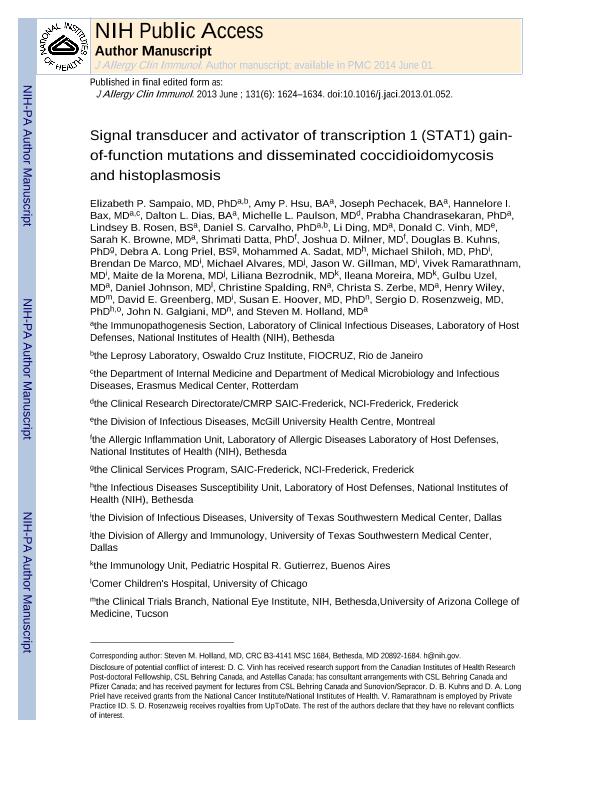Artículo
Signal transducer and activator of transcription 1 (STAT1) gain-of-function mutations and disseminated coccidioidomycosis and histoplasmosis
Sampaio, Elizabeth P.; Hsu, Amy P.; Pechacek, Joseph; Hannelore I.; Dias, Dalton L.; Paulson, Michelle L.; Chandrasekaran, Prabha; Rosen, Lindsey B.; Carvalho, Daniel S.; Ding, Li; Vinh, Donald C.; Browne, Sarah K.; Datta, Shrimati; Milner, Joshua D.; Kuhns, Douglas B.; Long Priel, Debra A.; Sadat, Mohammed A.; Shiloh, Michael; De Marco, Brendan; Alvares, Michael; Gillman, Jason W.; Ramarathnam, Vivek; de la Morena, Maite; Bezrodnik, Liliana ; Moreira, Ileana; Uzel, Gulbu; Johnson, Daniel; Spalding, Christine; Zerbe, Christa S.; Wiley, Henry; Greenberg, David E.; Hoover, Susan E.; Rosenzweig, Sergio D.; Galgiani, John N.; Holland, Steven M.
; Moreira, Ileana; Uzel, Gulbu; Johnson, Daniel; Spalding, Christine; Zerbe, Christa S.; Wiley, Henry; Greenberg, David E.; Hoover, Susan E.; Rosenzweig, Sergio D.; Galgiani, John N.; Holland, Steven M.
 ; Moreira, Ileana; Uzel, Gulbu; Johnson, Daniel; Spalding, Christine; Zerbe, Christa S.; Wiley, Henry; Greenberg, David E.; Hoover, Susan E.; Rosenzweig, Sergio D.; Galgiani, John N.; Holland, Steven M.
; Moreira, Ileana; Uzel, Gulbu; Johnson, Daniel; Spalding, Christine; Zerbe, Christa S.; Wiley, Henry; Greenberg, David E.; Hoover, Susan E.; Rosenzweig, Sergio D.; Galgiani, John N.; Holland, Steven M.
Fecha de publicación:
28/03/2013
Editorial:
Elsevier
Revista:
Journal of Allergy and Clinical Immunology
ISSN:
0091-6749
Idioma:
Inglés
Tipo de recurso:
Artículo publicado
Clasificación temática:
Resumen
Background: Impaired signaling in the IFN-g/IL-12 pathway causes susceptibility to severe disseminated infections with mycobacteria and dimorphic yeasts. Dominant gain-of-function mutations in signal transducer and activator of transcription 1 (STAT1) have been associated with chronic mucocutaneous candidiasis.
Objective: We sought to identify the molecular defect in patients with disseminated dimorphic yeast infections.
Methods: PBMCs, EBV-transformed B cells, and transfected U3A cell lines were studied for IFN-g/IL-12 pathway function. STAT1 was sequenced in probands and available relatives. Interferon-induced STAT1 phosphorylation, transcriptional responses, protein-protein interactions, target gene activation, and function were investigated.
Results: We identified 5 patients with disseminated Coccidioides immitis or Histoplasma capsulatum with heterozygous missense mutations in the STAT1 coiled-coil or DNA-binding domains. These are dominant gain-of-function mutations causing enhanced STAT1 phosphorylation, delayed dephosphorylation, enhanced DNA binding and transactivation, and enhanced interaction with protein inhibitor of activated STAT1. The mutations caused enhanced IFN-g–induced gene expression, but we found impaired responses to IFN-g restimulation.
Conclusion: Gain-of-function mutations in STAT1 predispose to invasive, severe, disseminated dimorphic yeast infections, likely through aberrant regulation of IFN-g–mediated inflammation
Archivos asociados
Licencia
Identificadores
Colecciones
Articulos(SEDE CENTRAL)
Articulos de SEDE CENTRAL
Articulos de SEDE CENTRAL
Citación
Sampaio, Elizabeth P.; Hsu, Amy P.; Pechacek, Joseph; Hannelore I.; Dias, Dalton L.; et al.; Signal transducer and activator of transcription 1 (STAT1) gain-of-function mutations and disseminated coccidioidomycosis and histoplasmosis; Elsevier; Journal of Allergy and Clinical Immunology; 131; 6; 28-3-2013; 1624-1634
Compartir
Altmétricas



